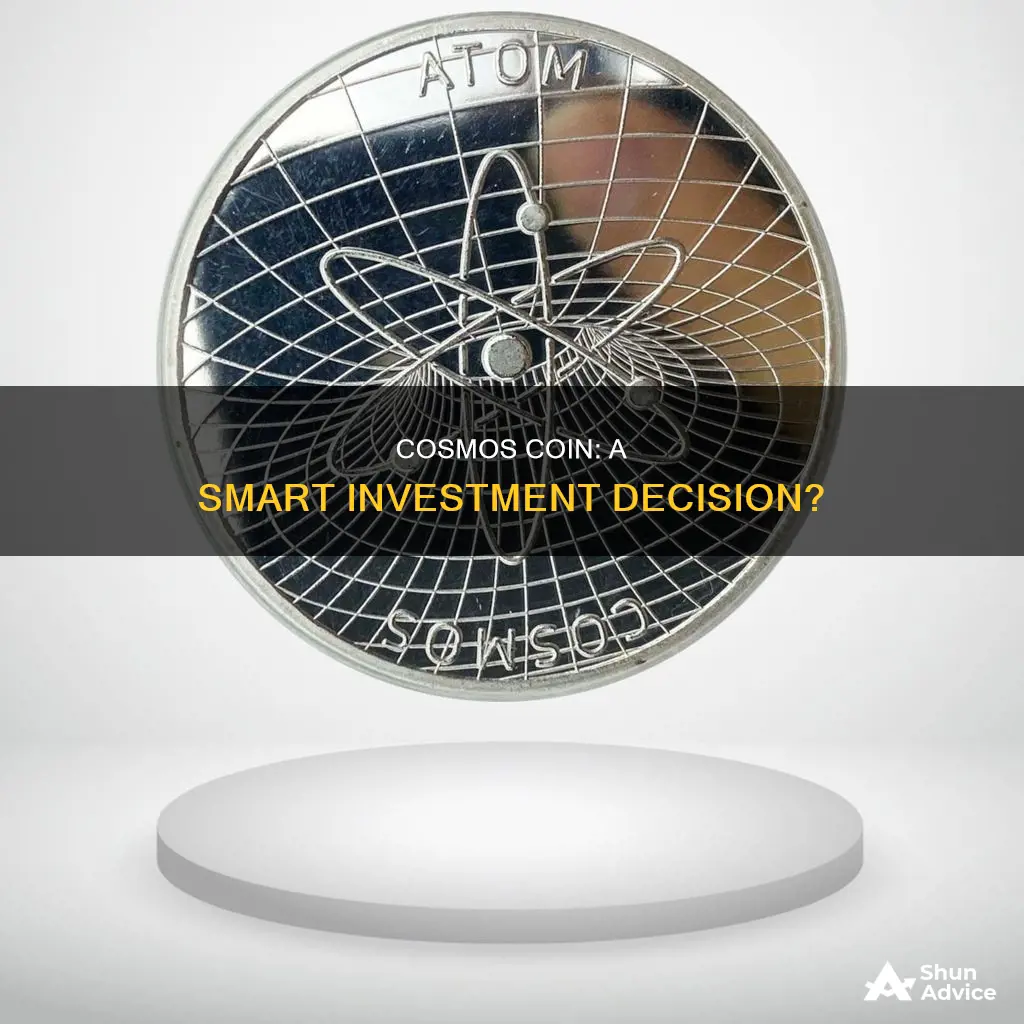
Cosmos (ATOM) is a blockchain ecosystem, often referred to as the 'Internet of Blockchains'. It is a de facto blockchain network with lots of smaller chains that can link up with each other to process information and carry out transactions.
The Cosmos price has had a tough time lately. In 2024, it trades close to its yearly low. However, it has also shown strong potential, with an average yearly increase of 276%.
Cosmos has several factors in its favour, such as its innovative technology, strong community support, and partnerships with prominent projects. It has the potential to revolutionize the blockchain industry with its interoperability and scalability solutions.
However, like any investment, there are risks to consider, such as market volatility, regulatory uncertainties, and competition from other blockchain solutions.
So, is Cosmos a good investment? Well, that's up to you to decide. Do your own research and never invest more money than you can afford to lose.
What You'll Learn
- Cosmos' native coin ATOM has had a tough time recently, trading close to its yearly low
- The Cosmos network is an ecosystem of interconnected blockchains
- Cosmos has an innovative technology with strong community support and partnerships
- The Cosmos Hub is the blockchain protocol underlying a large number of blockchains
- Cosmos has a wide range of use cases and applications across various industries

Cosmos' native coin ATOM has had a tough time recently, trading close to its yearly low
Cosmos' native coin, ATOM, has had a challenging period recently, trading close to its yearly low. However, it's important to note that the cryptocurrency market is subject to high volatility, and prices can change rapidly. While ATOM's value has been fluctuating, it still holds potential for growth and remains an attractive option for investors due to its innovative technology and strong community support.
ATOM's performance in 2024 has been lacklustre, with the coin trading near its yearly low. This follows a difficult 2023, where the slide in its value was exacerbated by the SEC labelling it an unregistered security. Additionally, the recent Gaia v17 upgrade did not have the desired effect on its price, and the platform suffered an outage shortly after its launch. These factors have contributed to ATOM's recent struggles.
Despite these challenges, ATOM still has the potential for growth and could offer attractive investment opportunities. Its parent network, Cosmos, is an ecosystem of interconnected blockchains that aims to improve scalability and interoperability in the blockchain industry. This addresses critical challenges in the blockchain space, and with ongoing developments, partnerships, and community support, Cosmos could become a leading player in the crypto market.
ATOM's historical data shows substantial growth potential, with an average yearly increase of 276% since its listing in March 2019. It reached an all-time high of around $44.70 in September 2021. While it is currently trading at a lower value, its past performance demonstrates its ability to achieve significant growth.
Industry experts offer varying predictions for ATOM's future price. Wallet Investor forecasts a price range of $5.45 to $10.77 by 2025. DigitalCoinPrice predicts a potential high of $15.61 by 2023 and $26.29 by 2025. These predictions indicate the potential for growth and stability in the long term.
It's important to remember that cryptocurrency investments carry risks, including market volatility, regulatory uncertainties, and competition. Therefore, investors should always conduct thorough research and consult with financial advisors before making any investment decisions.
The Ultimate Guide: Investing in Bitcoin in the US
You may want to see also

The Cosmos network is an ecosystem of interconnected blockchains
The Cosmos blockchain was developed to facilitate communication between distributed ledgers without relying on a centralized server. It uses hubs, the Tendermint consensus algorithm, and the Inter-Blockchain Communication (IBC) protocol to ensure that blockchains can communicate securely. The IBC protocol allows the transmission of secure messages between heterogeneous blockchains/zones and connects them to the Cosmos Hub, enabling users to freely and securely exchange assets and data across sovereign (autonomous) and decentralized blockchains.
The Cosmos Hub is regarded as a service provider to the chains that must connect to it to become interoperable. Any sovereign blockchain with different applications, validators, and consensus mechanisms can still communicate with each other and exchange data, regardless of their functions and business objectives. Each zone, or independent blockchain, connects to another zone through hubs. Cosmos Hub is the main one, but other hubs are also available.
The Cosmos network offers fast, secure, and scalable blockchain solutions, making it an attractive option for developers and users. It provides a streamlined development process that allows developers to create their own custom blockchain in months or even weeks, instead of years. The Cosmos SDK, a set of tools that allow developers to build decentralized and sovereign blockchain applications, further enhances the development process.
The native tokens of the Cosmos network are called ATOMs. Holding ATOMs gives holders the ability to stake and validate blocks, vote on governance issues, and pay for transaction fees. ATOM has seen significant gains since its inception, with an increase of nearly 600% in value. It achieved its all-time high of $38.78 in September 2021.
UK Guide: Investing Money in Bitcoin
You may want to see also

Cosmos has an innovative technology with strong community support and partnerships
Cosmos is an ecosystem of interconnected blockchains that aims to solve scalability and interoperability challenges in the blockchain industry. It operates on the Tendermint consensus algorithm and allows independent blockchains, called "zones," to interact through the Cosmos Hub. The Cosmos network offers fast, secure, and scalable blockchain solutions, making it an attractive option for developers and users.
Cosmos, also known as the 'Internet of Blockchains', is made up of hundreds of distinct blockchains that can all connect to one another and exchange tokens with ease. The open-source Cosmos technology, which is made available via a software development kit, serves as the foundation for all blockchains. This method reduces complexity while giving developers the freedom to include any features they want.
Cosmos features two kinds of chain: hubs and zones. Zones are the regular chains, which process information, and hubs link the zones together. The main hub is the Cosmos Hub itself, which has every zone linked to it. There are three segments to the network: consensus, networking, and application.
The Cosmos network serves as the underlying blockchain protocol for various projects. It enables interoperability between blockchains and seamless transfer of tokens and data. Significantly popular blockchains and dApps like dyDx and Binance Chain have connected with the Cosmos network. As of Q1 2023, the network has about 250 apps and assets under management valued at about $63 billion. Such wide adoption can lead to a further increase in price for ATOM, the native digital coin of the Cosmos network.
Smart Strategies for Bitcoin Investment
You may want to see also

The Cosmos Hub is the blockchain protocol underlying a large number of blockchains
Cosmos is a decentralized network of independent, parallel blockchains built with the Cosmos Software Development Kit (SDK). The Cosmos Hub is the blockchain protocol underlying an increasingly large number of blockchains built on the Cosmos Network, allowing them to communicate with each other. It is designed to generate thousands of interconnecting blockchain systems built on the Cosmos Network.
The Cosmos Hub uses a proof-of-stake consensus method that allows network participants to "stake" their ATOM coins and earn incentivized rewards. The Cosmos Hub uses various innovations to simplify software development, improve performance, heighten security, and create an interoperable blockchain infrastructure.
The Cosmos Hub is being built by the Tendermint Core team, which is the primary organization responsible for designing and contributing to the Cosmos Network. They play a key role in building critical network infrastructure such as the Cosmos Hub, Cosmos SDK, and Tendermint Core. The Tendermint team has constructed the Cosmos Hub as an interoperable blockchain platform that allows the protocol to connect with independent blockchains, known as "zones," within the Cosmos Network.
The Cosmos Hub is the flagship blockchain of Cosmos and acts as the steward for the Cosmos ecosystem. It plays an important role in bringing new features of the Cosmos SDK to market, such as the launch of IBC in 2021 with the Cosmos Hub's stargate upgrade. The Cosmos Hub utilizes the Tendermint consensus engine, which is one of the first Proof-of-Stake (PoS) consensus algorithms to be used in production. It is a Byzantine Fault Tolerant (BFT) system, allowing it to achieve consensus even when up to one-third of participating nodes go offline or act maliciously.
The Cosmos SDK is a scalable, open-source infrastructure designed to build multi-asset public PoS blockchain platforms such as the Cosmos Hub, in addition to permissioned proof-of-authority (PoA) blockchains. It allows developers to create customized blockchains using a series of modules and enables users to connect their own blockchain to the Cosmos Network via IBC, increasing liquidity and user adoption.
Coinbase Stock: A Guide to Investing in the Crypto Exchange
You may want to see also

Cosmos has a wide range of use cases and applications across various industries
Cosmos (ATOM) is an ambitious project that seeks to become the blockchain that connects all other blockchains through its interoperability platform. It is an ecosystem of interconnected blockchains that aims to solve scalability and interoperability challenges in the blockchain industry. The Cosmos network offers fast, secure, and scalable blockchain solutions, making it an attractive option for developers and users.
The wide range of use cases and applications of Cosmos across various industries can be attributed to its focus on interoperability and scalability. Here are some key aspects:
- Interoperability: Cosmos aims to connect different blockchains and facilitate seamless interactions between them. This capability enables blockchains to excel in their specific areas and cooperate with complementary strengths. It uses hubs to allow blockchains to communicate with each other, and each hub can connect to multiple blockchains through its Inter-Blockchain Communication (IBC) tool. This feature has attracted big-name crypto projects, including Binance Smart Chain and Crypto.com, to run applications on its network.
- Scalability: Cosmos addresses the scalability challenge in the blockchain industry by providing fast and efficient solutions. It claims that each transaction on its network costs $0.01, significantly lower than the median fee on Ethereum, which was around $10 as of March 2024.
- Decentralized Finance (DeFi): Several applications on the Cosmos network fall under the DeFi category. DeFi is a group of products that cut out intermediaries (usually banks) from financial services. Cosmos' interoperability and scalability features make it well-suited for DeFi applications, enabling seamless and cost-effective transactions.
- Tokenization: Cosmos can facilitate the tokenization of various industries. For example, one of the projects built on Cosmos, e-Money, is a European stablecoin issuer, while another project, Playlist, aims to tokenize the music industry.
- Blockchain-as-a-Service (BaaS): Cosmos provides an underlying blockchain protocol for various projects, enabling them to leverage its interoperability and scalability features. This BaaS model allows projects to focus on their specific use cases while utilizing Cosmos' robust infrastructure.
- Customizable and Modular Architecture: The Cosmos SDK is an open-source framework that allows developers to build application-specific blockchains easily. It provides modules and packages that developers can use to create chains compatible with the Tendermint Core, reducing redundant work. This flexibility attracts a wide range of projects, from decentralized exchanges to gaming and social networking platforms.
The diverse use cases and applications of Cosmos across industries, including finance, music, gaming, and blockchain-based services, highlight its potential to revolutionize the blockchain industry. Its focus on interoperability and scalability positions it as a significant player in the blockchain world, with the potential to become the "Internet of Blockchains."
The Ultimate Guide to Investing Bitcoin in the USA
You may want to see also
Frequently asked questions
Cosmos is an ecosystem of interconnected blockchains that aims to solve scalability and interoperability challenges in the blockchain industry. It is powered by the Tendermint Byzantine Fault Tolerant algorithm, which facilitates consensus-building even in potentially hostile node environments.
As of August 2024, the price of Cosmos ranges between $4.68 and $8.73.
According to various analysts, the price of Cosmos in 2024 could reach a maximum of $18.9, $12.17, or $24.29. However, it is important to remember that price predictions can often be wrong and that prices can go down as well as up.
Investing in Cosmos offers both risks and rewards. On the rewards side, Cosmos has the potential to revolutionize the blockchain industry with its interoperability and scalability solutions. It also has a strong development team and a growing ecosystem. However, there are risks to consider, such as regulatory challenges, market volatility, and the emergence of competing projects.
Cosmos has consistently been ranked around the top 30 cryptocurrencies over the last few years, and it offers a unique solution to scalability and interoperability challenges. However, it has also faced regulatory issues and competition from other projects. Ultimately, whether or not to invest in Cosmos is a decision that should be made based on thorough research and an individual's risk tolerance.







